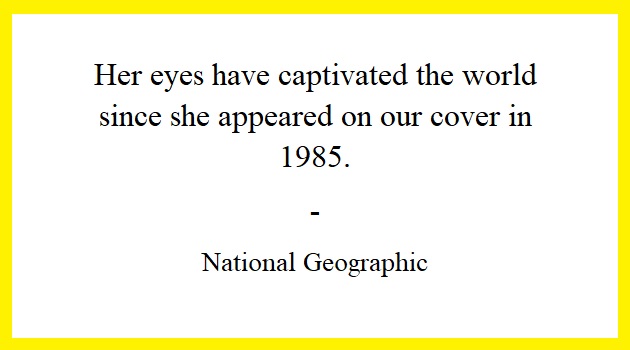Everyone saw Sharbat Gula when her eyes pierced through an international magazine’s cover. That was in 1985.
Recently, Sharbat Gula hit the headlines again. This time, the green-eyed Afghan girl was evacuated by the Italian government after the Taliban takeover of Afghanistan.
What happened in 1985

Steve McCurry – a photographer for National Geographic magazine – spotted Afghanistani girl Sharbat Gula at a refugee camp at Peshawar in Pakistan. Amid a sea of tents, there was one school tent where Sharbat Gula was photographed.
Orphaned at age six during the Soviet invasion of Afghanistan, she had trekked by foot to Pakistan with her siblings and grandmother.
Her photograph – a portrait, to be precise, became the face of the ‘ordeal of Afghanistan’s refugees’ when it was published on the cover of the international magazine.
The follow up in 2002
Seventeen years later, National Geographic again wrote about her, commenting on the same portrait with description like, (her) ‘eyes are sea green. They are haunted and haunting, and in them you can read the tragedy of a land drained by war.’
By then, the girl had shifted to the mountainous Tora Bora region of Afghanistan, where she was ‘traced’ by photographer Steve McCurry who travelled to the region as part of a crew from National Geographic Television & Film.
“She’s as striking as the young girl I photographed 17 years ago,” said Steve McCurry in a feature run by National Geographic in 2002.
Evacuation to Rome in 2021
Sharbat Gula, now in her late 40s, was evacuated to Rome in November 2021 after Afghanistan fell to the Taliban.
According to a statement by the Italian government, civil society and non-profit organizations had appealed for help in evacuating Gula ever since the U.S. pulled out of Afghanistan in August.
“The prime minister’s office has brought about and organized her transfer to Italy,” the statement said.
“Afghan citizen Sharbat Gula has arrived in Rome,” notified the Presidency of the Council of Ministers of the Italian government, on November 25, 2021.
“… the Presidency of the Council of Ministers has made this possible, organising for her to travel to Italy as part of the wider evacuation programme in place for Afghan citizens and the Government’s plan for their reception and integration,” it added.
The other side of Sharbat Gula
Her story exemplifies what Nigerian author Chimamanda Ngozi Adichie has termed “the danger of a single story.” The narrative constructed around Sharbat Gula’s portrait was that of a girl whose eyes reflected ‘the fear of war’.
It helped people realize the gravity of the Afghan refugee crisis during the Soviet war in Afghanistan. But the question remains – did National Geographic magazine rightfully run Sharbat Gula on the cover?
Another question that needs to be answered is if the Afghan girl was turned into a spectacle that was displayed in the Western museums!
Was hers the ‘haunted eyes’ or the eyes that were ‘nervous and scared’? We may not be able to know the truth, though.
In Pashtun culture, it is not allowed for the girls to show their faces to an unknown man, let alone the whole world.
Then, was Sharbat Gula intentionally photographed for the magazine cover? A narrative of fear could be constructed with this picture with no one caring about the real story of a little girl.
In a telling video, popular photographer Tony Northrup reveals that “he (Steve McCurry) poses her like an 80s’ glamour shot, shoulder tilted towards the camera, forehead forward, nice light to illuminate the eyes and direct eye contact – something she would never ever do.”
Well, for decades, people were only aware of the single story that photographer Steve McCurry had presented to the world, including the version that she was an ‘orphan’ at the time of being photographed.
At one instance, Sharbat Gula’s been quoted elsewhere that she had traveled to Pakistan with her father, who was ‘alive’ at the time her picture was taken.
With the recent news of her rescue by the Italian government, she is once again in a situation where her story is given meaning by someone else.
With so many stakeholders associated with Sharbat Gula’s life, it is hardly possible that we will ever get to hear her real story.